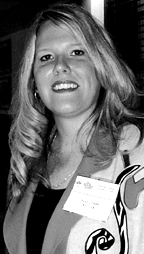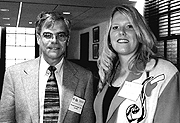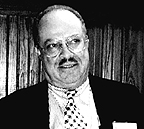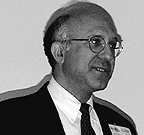
| T H E N I H C A T A L Y S T | J U L Y – A U G U S T 1999 |
|
|
|
NIH Name Appears on DegreeFirst Genetics Grad Feted by GWU-NIH |
by Fran Pollner |
 |
|
Susan Zullo
|
In a twist of timing, just a few weeks before NIH decided to recast its graduate school plans, the first-ever doctoral diploma with "National Institutes of Health" embossed on its face was handed to Susan Zullo.
In May, Zullo got her Ph.D. in genetics at the George Washington University (Washington, D.C.) commencement—and a party thrown in her honor on the NIH campus.
She is the first student to go through the first full-scale doctoral program jointly sponsored by NIH and a degree-granting institution. And to her knowledge, she’s the first holder of a degree that boasts "in conjunction with the NIH" on its printed face.
The NIH name on the diploma means a great deal to her, Zullo said, and she lobbied heavily to set the precedent–for herself and "everyone else" who follows. (In deciding to suspend efforts to become a degree-granting institution in its own right, NIH is opting instead to focus on improving existing collaborations like this one; see DDIR column and NIH Morphs Graduate School Idea.)
 |
|
Susan
Zullo (right) with Michael
Gottesman, deputy director for intramural research
|
"Everyone else," at the moment, are the 17 GWU doctoral students currently in the joint GWU-NIH genetics program, which was launched in 1993 and enrolled its first four students in the fall of that year. Zullo is the only one of this pioneering group to go the distance. Those who followed Zullo onto the NIH campus in subsequent years—at the rate of four or five each year (a number she says fits well)—are enjoying not only the benefits of the program itself but of her having cleared the path, along with her mentors and program directors, of some of the hidden obstacles that thwarted travelers along the way.
"At first, it was a free-for-all. You couldn’t find your way around Building 10 the first year, much less the campus," she recalled, noting that travel between GW for coursework and NIH for research could involve multiple treks back and forth on a daily basis. But one of the biggest problems initially was being directed to a good mentor. She shuttled between laboratories before landing at the Clinical Gene Therapy Branch of NHGRI, where, under the guidance of lab chief Michael Blaese and principal investigator Richard A. Morgan, she conducted research on novel gene delivery systems. Her doctoral thesis dealt with alphaviruses as gene therapy vectors.
Bureaucratic problems in the joint graduate program were cited as a cautionary tale during an NIH-wide town meeting to discuss the idea of an NIH graduate school. A fourth-year student said that confusing paperwork and delayed payments (GW provides tuition waivers for coursework and NIH provides research stipends at the pre-IRTA level) had led to a "high dropout rate." Another student noted that newer arrivals have had fewer logistical and pay problems than their predecessors.
Though she was first to face and resolve these snafus, Zullo found the experience of doing research at NIH throughout her years of doctoral coursework wholly exhilarating. "Where else can you be surrounded by this quality of scientists? Where else can you work with the people who developed the technique, discovered the gene, wrote the book? Where else can you go from basic research into the clinic? And there are some wonderful mentors here," she said.
Zullo was awarded a Congressional
Science Fellowship that begins September 1. She’ll be working with a member
of Congress on Capitol Hill, where she hopes to focus on genetics-related funding,
mentoring, and discrimination issues, as well as address public misconceptions
about clinical gene research. Being at NIH, she said, has shown her the "impact
of science policy on science." ![]()
| Partners in the Party—and the Program |
 |
 |
 |
 |
| Diana Johnson, acting GWU program director |
Jim
Alexander, deputy director, NIH Office of Education
|
Simeon
Taylor, NIDDK, former mentor and chairman of steering committee
|
Michael
Blaese, NHGRI, mentor
|